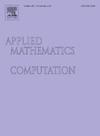Maximal and maximum induced matchings in connected graphs
IF 3.5
2区 数学
Q1 MATHEMATICS, APPLIED
引用次数: 0
Abstract
An induced matching is defined as a set of edges whose end-vertices induce a subgraph that is 1-regular. Building upon the work of Gupta et al. (2012) [11] and Basavaraju et al. (2016) [1], who determined the maximum number of maximal induced matchings in general and triangle-free graphs respectively, this paper extends their findings to connected graphs with n vertices. We establish a tight upper bound on the number of maximal and maximum induced matchings, as detailed below: This result not only provides a theoretical upper bound but also implies a practical algorithmic application: enumerating all maximal induced matchings of an n-vertex connected graph in time . Additionally, our work offers an estimate for the number of maximal dissociation sets in connected graphs with n vertices.
连通图中的最大和最大诱导匹配
诱导匹配被定义为一组边,其端点诱导出一个1正则子图。Gupta et al.(2012)[11]和Basavaraju et al.(2016)[1]分别确定了一般图和无三角形图的最大诱导匹配的最大数量,在此基础上,本文将他们的发现扩展到具有n个顶点的连通图。我们建立了最大和最大诱导匹配个数的紧上界,具体如下:{(n2)if1≤n≤8;(⌊n2⌋2)⋅(作答作答作答作答作答作答作答作答作答作答作答作答作答作答作答作答作答作答作答作答作答作答作答作答作答作答作答作答作答作答作答作答作答作答作答作答作答作答作答作答作答作答作答作答作答作答作答作答作答作答作答作答作答作答作答作答。这个结果不仅提供了一个理论上的上界,而且还暗示了一个实际的算法应用:枚举时间为O(1.5849n)的n顶点连通图的所有极大诱导匹配。此外,我们的工作还提供了具有n个顶点的连接图中最大解离集数量的估计。
本文章由计算机程序翻译,如有差异,请以英文原文为准。
求助全文
约1分钟内获得全文
求助全文
来源期刊
CiteScore
7.90
自引率
10.00%
发文量
755
审稿时长
36 days
期刊介绍:
Applied Mathematics and Computation addresses work at the interface between applied mathematics, numerical computation, and applications of systems – oriented ideas to the physical, biological, social, and behavioral sciences, and emphasizes papers of a computational nature focusing on new algorithms, their analysis and numerical results.
In addition to presenting research papers, Applied Mathematics and Computation publishes review articles and single–topics issues.

 求助内容:
求助内容: 应助结果提醒方式:
应助结果提醒方式:


